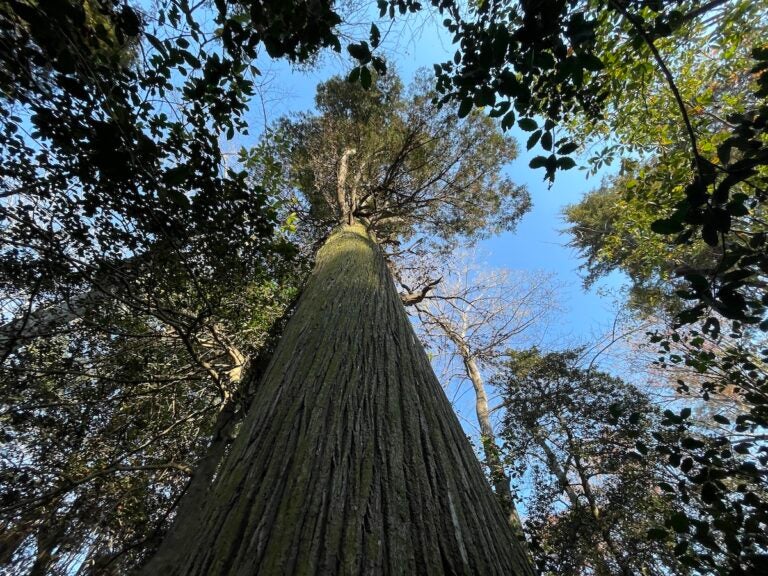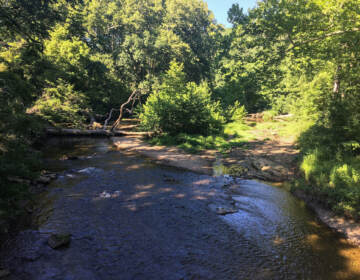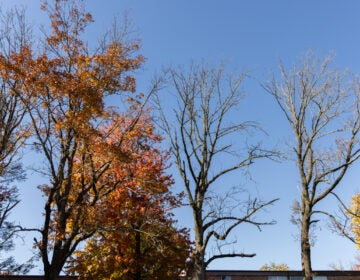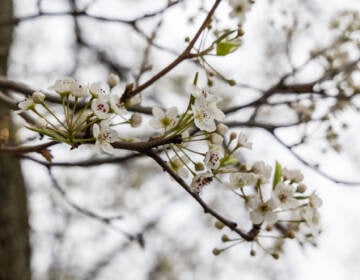A rare find: Largest Atlantic white cedar tree found in Delaware
The discovery of the state's largest Atlantic white cedar tree reveals its rarity. Cedars were heavily logged over the centuries.
Listen 1:44
Atlantic white cedar at TNC's Ponders Tract. (Courtesy of The Nature Conservancy)
From Philly and the Pa. suburbs to South Jersey and Delaware, what would you like WHYY News to cover? Let us know!
Deep in the southern Delaware woods, along the trails of Ponders Tract near Milton, sits a majestic sight. The largest Atlantic white cedar tree in the state stands tall and straight, with a flaky, grayish-brown trunk. Its impressive canopy reaches high, adorned with lush evergreen foliage, creating a captivating presence in the heart of the swamp.
The tree was recently discovered by Natasha Whetzel on one of her regular visits to Ponders Tract as she explores the landscape and measures water levels in her role as stewardship program manager for the Nature Conservancy. Those visits also include keeping an eye out for diverse plant species.
“I had kind of known about these two larger Atlantic white cedars on our property for a few years, but I had never really reached out to anybody to confirm them being potentially the largest in the state,” she said. “I found these along our Piney Branch at our Ponders Tract Trail system, part of our Pemberton Forest Preserve. Essentially, every year I like to see what kind of plants we have growing and walking along the branch. Suddenly, I kind of was struck when I came across two very large ones.”
Discovering Delaware’s largest Atlantic White Cedar tree in the secluded Ponders Track woods highlights its rarity, especially since it was cut and logged in the 1700s.
Here’s a video from the @nature_org pic.twitter.com/grqt4xsY0S
— Johnny Perez (@johnnyperez__) February 1, 2024
Stunned by the sheer size of the tree known to scientists as Chamaecyparis thyoides, Whetzel couldn’t quite grasp its magnitude. To better understand, she called upon Bill McAvoy, a botanist with the Delaware Department of Natural Resources and Environmental Control.
Upon examination, the botanist confirmed that this tree is indeed the largest in the state of Delaware, measuring an impressive 38 inches in diameter at chest height. In comparison, other trees measured across the state typically range from 25 to 36 inches.
“They’re quite attractive, these particular trees being so large and tall. It’s a species that ranges from New England, south into Georgia, and it’s a species that you find growing in floodplain wetlands along the streams of Sussex County,” he said. “Usually, when you find Atlantic white cedar, you usually find it in abundance. It’s usually the dominant species that grows in these wetlands.”
‘A globally rare butterfly’
Cedar trees are much more rare now then they were historically. They were especially impacted by logging during the 1700s.
“Atlantic white cedar wetlands used to be a lot more common and prominent in Delaware, and due to historical logging practices, which was around the European colonization, around the 1700s, Atlantic white cedars were harvested nearly to extinction for things like ship buildings and shingles,” said Whetzel. “So we’re struggling today to maintain these Atlantic white cedar wetlands.”
Despite the limited number of trees of its kind, it plays a crucial role as a host plant, attracting some of the rarest species in the state, including swamp pink, yellow crested orchid, slender rose gentian, and even a rare and endangered butterfly.
“There’s a globally rare butterfly called Hessel’s hairstreak and Atlantic white cedar is the host plant for this butterfly. Meaning that the species does not exist without Atlantic white cedar, the caterpillars feed on the foliage of the Atlantic white cedar,” McAvoy said.
The Hessel’s hairstreak was spotted by a Delaware State University entomologist in 2022. It was the first time it’s been seen on the Delmarva peninsula in 27 years.
Botanists like McAvoy are thrilled to discover more of these trees that have managed to elude the axes and saws of lumberjacks. He extends an invitation to tree lovers and nature enthusiasts to come take a look, but emphasizes that reaching this particular tree would require special guidance for visitors.

Get daily updates from WHYY News!
WHYY is your source for fact-based, in-depth journalism and information. As a nonprofit organization, we rely on financial support from readers like you. Please give today.







